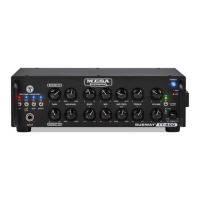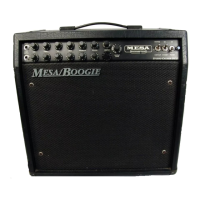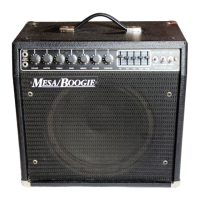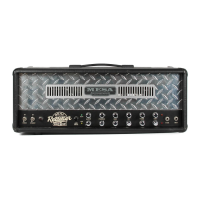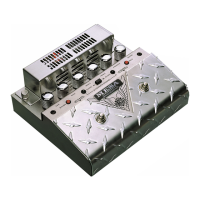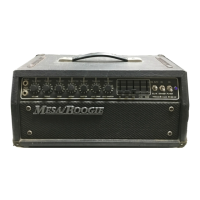mines the overall playing volume of the SUBWAY WD-800. Using the MASTER VOLUME along with the INPUT GAIN control allows
the optimal control over playing volume. For example, if you are using high input gain to achieve an overdriven tone, it will be likely
be necessary to adjust the master volume down to obtain a reasonable playing volume and to avoid excessive overdriving of the
power amp. Likewise, if you are looking for a very clean tone, you may wish to start with a lower INPUT GAIN control setting and use
a higher MASTER VOLUME control setting to obtain the desired playing volume. The MASTER VOLUME control operates in a linear
fashion, an increase in volume continues linearly throughout the entire rotation of the control.
POWER AMP DAMPING CONTROL:
This control is responsible for amount of damping that the amplifier places on the
speaker. Because this is an unusual, but very useful control, some discussion of what damping is will help you understand why this
control may be so important to some players.
One of the primary differences between solid state and tube amps is how tightly the speaker is coupled to the power amplifier’s output
stage. All amplifiers have some resistance (more correctly, impedance) between the power circuitry and the speaker. This impedance
greatly affects how tightly the amplifier can control the speaker. High damping means that there is very little impedance between
the amplifier’s output circuitry and the speaker, the feel will be tighter and more controlled. Low damping means that there is more
impedance between the amplifier’s output circuitry and the speaker, the feel will be looser and less controlled. Because a speaker is
a complex impedance, this “lower damping” interaction can be responsible for a bit more “bloomy”, organic feel.
Generally, tube amps fall into the low damping category while solid state amps fall into the medium to high damping category. Speakers
have mass and the force required to accelerate the mass back and forth comes from the power generated by the amp and delivered
through the voice coil sitting within the magnetic gap of the speaker’s motor. This means that to accurately accelerate and decelerate
the cone at each end of its travel requires efficient power delivery to the speaker. As the power delivery becomes less efficient, the
force becomes less and the cone accelerates and decelerates more sluggishly, corresponding to undershoot and overshoot of the
cone. This, plus native voicing, are the most likely explanations for the “bloomy”, slightly “round bottom” feeling reputation that many
tube amps enjoy.
In tube amps, the impedance between the output stage and the load is high (resulting in a low damping factor of maybe 25) while in
a solid state amp the impedance between the output stage and the load is low (resulting in a high damping factor of maybe 500 to
1000). These are inherent properties of the respective topologies. These damping factor numbers also vary with frequency, as does
the speaker impedance, so the interaction is quite complex actually.
What does this mean? With lower damping, the amp will tend to feel a little looser (especially on the low end), a little bloomy, and a
little more organic. While there will be some tonal differences, it’s really more of a feel difference. With higher damping, the amp will
feel a little tighter and more controlled on the bottom end, and to some players it may feel more “immediate”. This control allows the
player to adjust the damping to accommodate a wider range of tastes. In general, the lower damping will work better at lower volumes
and the higher damping will work better at higher volumes (especially in a boomy room) where better cone control and tighter low end
might help the bass fit better into a mix. Because amplifier damping interacts with speaker impedance, different speakers will behave
differently. As a generality, a sealed cabinet, which has high intrinsic electro-mechanical damping will probably feel a little better with
a lower amp damping. A ported cabinet on the other hand typically has lower intrinsic electro-mechanical damping and will probably
feel a little better with a higher damping. There are some ported cabinets with tunings that result in a serious under-damped response
and these cabinets in particular tend to work better with the highest damping. Let your ears and fingers be the ultimate judge. It should
be noted that the effect is very speaker dependent, and somewhat subtle. This feature is simply another tool to allow “feel based”
players a little more control under a wider variety of playing conditions when necessary.
POWER LED:
This blue LED indicates that the amplifier is connected to a power source and is switched on, operating correctly.
If this LED is not on, double-check the power source, and be sure the power cable is firmly inserted into the IEC power inlet socket.
2 OHM LED:
This blue LED indicates that the amplifier’s 2 ohm operating mode has been selected via the 2 OHM switch
located on the rear panel.
PROTECT LED:
This red LED indicates that the amplifier has entered protect mode and is either protecting itself from an ex-
ternal fault (such as blocked ventilation, shorted speaker cable or defective speaker), or that there is an internal fault within the amp
PAGE 5
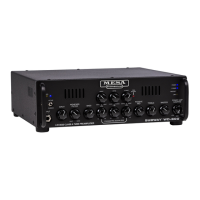
